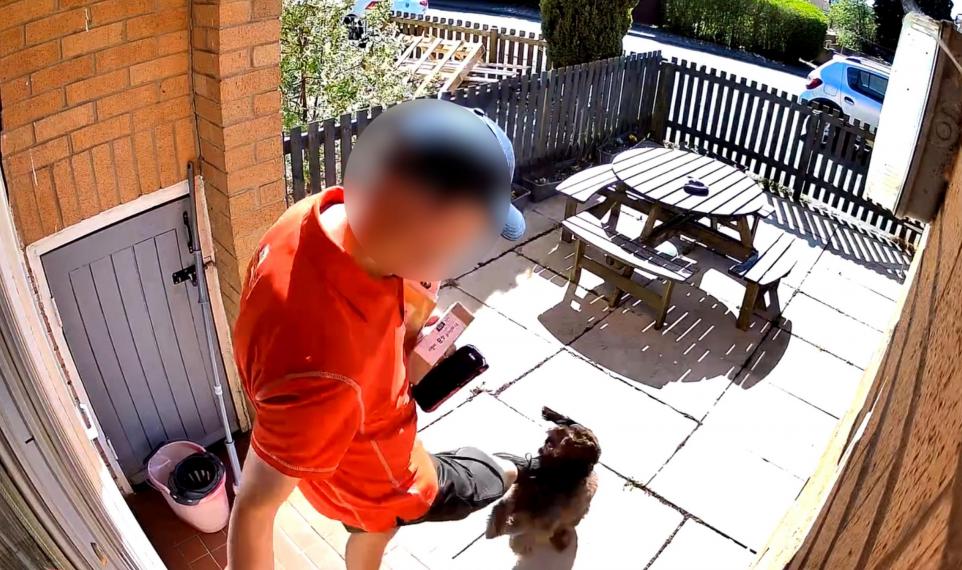What’s more familiar than the sound of paws scrambling toward the door when the postman arrives? For many pet owners, it’s a harmless routine—dogs bark, tails wag, and letters hit the floor. But what happens when that everyday moment takes a violent turn?
In Leeds, a doorbell camera captured a postman kicking a one-year-old cockapoo named Bella in the face—an act that set off a wave of outrage, debate, and scrutiny. The footage showed no snarling or lunging, just a small dog running toward a visitor with visible excitement. Seconds later, she was yelping in pain and cowering on the couch.
Royal Mail stood by its broader safety policy, citing more than 2,200 dog attacks on postal workers in the past year. But this incident struck a nerve—because what many saw wasn’t self-defense. It was an overreaction. A trusted public employee using force on a dog that posed no clear threat.
Where should the line be drawn between caution and cruelty? How much responsibility do dog owners carry—and what happens when delivery workers make the wrong call?
What Really Happened
On April 17 in Leeds, a one-year-old cockapoo named Bella was kicked in the face by a Royal Mail postman. The moment was recorded on a doorbell camera and quickly spread online, sparking public outrage.
According to Bella’s owner, Nikki Walker, the puppy had leapt through a ground-floor window after hearing the garden gate open—a typical reaction from a dog excited by a visitor. Bella ran toward the postman, tail wagging, showing no signs of aggression. As she approached, the man turned and kicked her directly in the face with his right foot.
The impact sent Bella tumbling backwards. She immediately squealed, ran into the house, and curled up on the sofa—shaken and visibly in pain. Nikki, who was working from home, rushed outside after hearing the yelp. When she confronted the postman, he denied kicking the dog and claimed he had simply raised his leg to stop her from jumping. His parting words: “Do what the f*** you want.”
Once Nikki reviewed the footage, her anger turned to disbelief. She described Bella as affectionate and docile—”a cuddle-loving puppy” who has never shown aggression toward anyone. Her daughter, who also watched the video, was reportedly in tears.
Despite the footage, Royal Mail’s initial response focused on worker safety. They offered Nikki £100 in compensation and requested she install a new fence—at her own expense—before mail service to her address could resume. The postman was eventually removed from her delivery route, but no details were provided about further disciplinary action.
What made the situation worse, in the eyes of many, was how quickly the conversation shifted from the dog’s trauma to the company’s protocols. And while Royal Mail cited two previous worker complaints about Bella growling—none involved actual bites or physical harm.
For many who saw the footage, Bella wasn’t a threat. She was a friendly dog reacting to a familiar sound, and the postman’s response didn’t look like fear—it looked like aggression.
A Tense History
Dog encounters are nothing new for postal workers. The image of a dog chasing the mailman isn’t just a cartoon stereotype—it’s based on real, frequent incidents. In the UK alone, Royal Mail reported 2,206 dog attacks on postal staff in the 12 months leading up to March 2024, a 15% increase from the year before. These aren’t minor nips, either—some incidents result in life-altering injuries, with workers sidelined for weeks or even months. One attack led to an entire street in Liverpool being cut off from mail service for six months.
This long-standing friction often comes down to instinct. Dogs are territorial. They react to perceived intrusions—someone entering a garden, reaching through a letterbox, or walking up the front path. And for postal workers, those same actions are part of their daily routine. Over time, Royal Mail has adapted by issuing safety guidance, suspending deliveries to addresses deemed high-risk, and even pursuing legal action against dog owners when necessary.
But the conflict isn’t just about safety—it’s about unpredictability. Most dog-related incidents happen in the front garden or at the door. Some dogs bark but stay put. Others slip through a gate or bolt out of the house. And postal workers are expected to make split-second decisions in these moments, not all of which are well-judged.
Still, not every encounter with a dog justifies physical force. The tension between risk and responsibility is where this issue gets murky. Yes, workers face real danger. But when an animal shows no aggressive behavior—no barking, no lunging, no signs of threat—a kick to the face raises serious questions.
Bella’s case stands out because it challenges the assumption that all dog-postman interactions are confrontational by default. It shows what can happen when a real safety concern becomes a blanket justification for harmful actions. And it forces both postal services and pet owners to reconsider how we define—and respond to—risk.
Understanding the Line Between Safety and Cruelty
Dog-related injuries are a serious and growing concern for postal workers. Royal Mail reported over 2,200 dog attacks on staff in the past year alone—a 15% increase from the previous year. Some of those incidents have led to life-changing injuries, time off work, and even private prosecutions. Given these numbers, it’s clear why the company emphasizes safety protocols and urges pet owners to secure their dogs during deliveries.
But the question in Bella’s case is not whether safety matters—it’s whether the postman’s response matched the situation in front of him.
The doorcam footage shows Bella running toward the delivery worker with her tail wagging. There’s no growling, no barking, and no signs of aggression. She doesn’t leap or snap. Instead, she’s abruptly kicked in the face mid-stride. For many viewers—including dog trainers, animal advocates, and everyday pet owners—that moment didn’t resemble a defensive action. It looked like a deliberate kick.
Royal Mail maintained that the postman was acting to protect himself and cited previous reports of Bella growling at other workers. But even if those reports were accurate, they involved no contact, no chasing, and no injuries. More importantly, on the day in question, there was no indication that Bella posed a threat.
Self-defense isn’t just about fear—it’s about proportional response. A worker turning away, stepping back, or even using a firm vocal command would’ve been understandable. A boot to the face isn’t just excessive—it’s violent. And when that action is captured on video, with no visible provocation, it stops being a matter of “safety” and becomes a question of judgment.
This also highlights a larger issue: Are delivery workers given the tools and training to assess animal behavior under pressure? Recognizing the difference between an enthusiastic dog and an aggressive one isn’t always easy—but it’s critical. Because when they get it wrong, the consequences aren’t just professional. They’re personal—for both the pet and the family behind the front door.
What Dog Owners Need to Know
Under UK law, it’s a criminal offence to have a dog that is “dangerously out of control,” even on your own property. According to the Crown Prosecution Service, this doesn’t just mean if your dog attacks someone. If your dog causes someone to fear they might be injured, that alone can count as being out of control. And it’s not just humans—if your dog harms another animal or causes a person to fear injury while trying to protect their pet, you could still be liable.
There are limited exceptions. One of them is the so-called “householder exemption,” which protects you if a trespasser is attacked inside your home. But this does not apply to delivery workers. In a key case, the court ruled that putting fingers through a letterbox does not make a postman a trespasser. The same logic applies to front gardens and driveways.
If your dog is found to be out of control and causes harm, the penalties can be serious:
- Injury to a person can lead to up to 5 years in prison, or 14 years if the person dies.
- Injury to another animal or even causing someone fear can lead to fines or control orders.
- Courts may also order your dog to be destroyed, regardless of whether it was the first incident.
In addition to criminal consequences, you could face a civil lawsuit. Royal Mail offers compensation for injured staff, and dog owners can be held liable under the Dogs Act 1871. That means even if you avoid criminal charges, you may still have to pay compensation for injuries, time off work, or psychological distress.
Royal Mail has made it clear: if your dog is deemed a risk—even if there’s no physical contact—they can suspend deliveries to your home. This policy has already been enforced in some areas, including an entire street in Liverpool that went without mail for six months after a serious dog attack.
For dog owners, the takeaway is simple: being friendly or small doesn’t exempt a pet from scrutiny. If your dog is able to reach the front garden during delivery hours, you’re at risk. Even a one-off incident can lead to mail suspension, legal trouble, or worse.
How to Prevent Incidents Like This
Preventing situations like Bella’s doesn’t require elaborate systems—it comes down to a few clear, manageable steps that can make a major difference for both your pet and the people coming to your door.
Secure Your Dog During Delivery Hours
The simplest and most effective move is keeping your dog out of access areas when deliveries are expected. That means no loose access to the front garden, driveway, or hallway near the front door. Use child gates indoors, locked garden gates outdoors, and make sure windows or doors aren’t left open where a dog could slip through.
If your pet is reactive or even overly enthusiastic around visitors, deliveries can be overwhelming. Remove that variable entirely by planning ahead.
Train for Door Behavior
Basic obedience training isn’t just for big dogs or so-called “problem” breeds. Teaching your dog to “stay,” “go to bed,” or “leave it” when the doorbell rings gives you control in moments that can escalate quickly. Even non-aggressive dogs can cause fear if they charge toward someone—especially a stranger who doesn’t know their intent.
Consider working with a trainer if your dog tends to bolt, jump, or bark at the door. These are manageable behaviors that can be improved with consistency.
Install Clear Physical Barriers
If your home layout allows pets access to the front garden, install proper fencing that prevents them from getting near delivery personnel. A low fence may not be enough if your dog can jump or squeeze through gaps. Secure gates with latches and make sure they self-close. This doesn’t have to be expensive, but it should be reliable.
If Royal Mail or another service has raised concerns, a visible improvement—like a locked gate—can make the difference between continued delivery and a long-term suspension.
Add a Delivery-Friendly Sign
Simple signage like “Dog in Garden – Do Not Enter” or “Please Wait, Dog Inside” helps delivery workers know what to expect. It’s a low-cost way to communicate and manage expectations before anyone walks through your gate.
Use Tech to Your Advantage
If you have a doorbell camera, use it to monitor your dog’s behavior and how workers respond. It can help clarify misunderstandings and keep both sides accountable. Some pet owners also use smart locks or delivery boxes that limit contact altogether—especially useful if you’re away during typical delivery windows.
Know Your Pet’s Triggers
Every dog has a threshold. Some bark but don’t bite. Others may fear strangers or react unpredictably. Know what makes your dog nervous, and be honest about whether they’re ready to greet unfamiliar people. Overestimating how “friendly” your dog is can backfire—especially if the person on the receiving end doesn’t share your comfort level.
Safety Without Cruelty
Bella’s case struck a nerve because it sits at the intersection of two legitimate concerns: protecting workers and treating animals humanely. Both matter. But when safety is used to excuse unnecessary force, we risk normalizing harm under the guise of precaution.
Delivery workers face real risks—over 2,200 dog-related incidents were reported by Royal Mail last year. These aren’t just statistics; they represent injuries, lost workdays, and emotional strain. But not every encounter with a dog is a threat. And not every response labeled “defensive” is justified.
What happened to Bella wasn’t an unavoidable accident. It was a choice, captured on camera, that shows how easily fear—or a lack of understanding—can turn into something more damaging. A wagging tail should not be treated the same as a warning growl.
This isn’t just about one postman or one dog. It’s about how we respond in moments that test our judgment. Delivery services must continue to prioritize staff safety—but they must also train employees to distinguish between danger and harmless interaction. And when lines are crossed, accountability has to follow, not just policy statements.
For dog owners, this is a reminder that responsible pet ownership doesn’t stop at loving your animal. It includes clear boundaries, consistent training, and ensuring your home is safe for visitors—even uninvited ones.
At its core, this is about common sense and compassion. Being cautious should never mean being cruel. And in a world where almost everything is recorded, how we act in small moments matters more than ever.
Featured Image Credits Kennedy News and Media








Leave a Reply